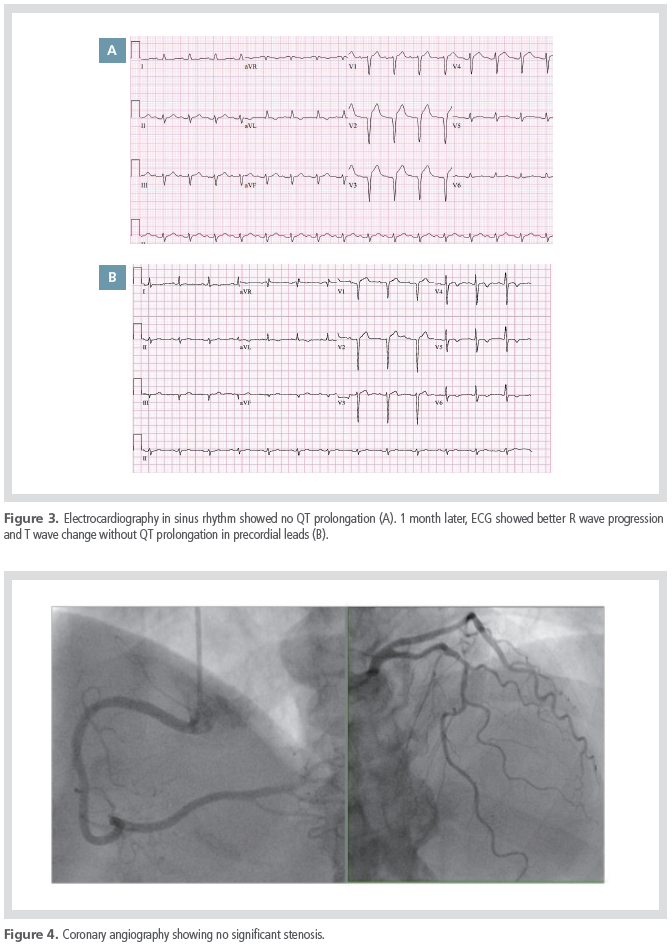|
|
International Journal of Arrhythmia 2014;15(3): 72-75.
|
 |
| ECG & EP CASES |
Intractable Ventricular Tachycardia
Associated With Stress Cardiomyopathy |

|
|
 |
 |

Introduction
Stress cardiomyopathy (SCM)-also known as
Takotsubo cardiomyopathy-is a common clinical
condition with a clinical presentation that
similar to acute myocardial infarction. Such patients
may present with chest pain, ST changes
on electrocardiography (ECG), elevated cardiac
enzyme levels, and regional wall motion abnormalities
of the left ventricular wall. However,
the coronary arteries appear normal in such
cases and the prognosis is good. Patients with
SCM also present with QT prolongation on ECG.
However, only a few cases of SCM presenting
with ventricular tachycardia (VT) associated with
long QT have been reported. In the present report,
we describe a case of a 75-year-old patient
with medically intractable monomorphic VT associated
with SCM.
Case
A 75-year-old woman was transferred to the
emergency room of our hospital for chest discomfort that developed during neuroplasty for
lumbar spinal stenosis. She was receiving medication
for diabetes mellitus and hypertension.
Upon arrival to the emergency room, her ECG
showed a sustained wide QRS tachycardia of 150
bpm. Her blood pressure was 90/50 mmHg. We
suspected the presence of monomorphic VT, and
hence, electrical shock was delivered. After repeated
administration of electrical shock, the
QRS axis changed, but the wide QRS tachycardia
persisted (Figure 1). Most of the VTs were monomorphic,
but occasionally, the QRS axis changed
spontaneously (Figure 2). The patient underwent
electrical shock more than 30 times within 12
hours to terminate the recurrent VT. Because the
QT interval of the sinus rhythm was normal (Figure
3), amiodarone was infused for the recurrent
VT.


Subsequently, VT changed to the nonsustained form and then gradually resolved.
Thereafter, echocardiography showed akinesia
of the middle and apical wholesegments. Extensive
ischemia of the left anterior descending
artery was suspected, but the findings were also
compatible with stress-induced cardiomyopathy.
In addition, coronary angiography indicated no
significant stenosis (Figure 4).
Amiodarone administration was discontinued
because of the development of QT prolongation
during drug infusion. With supportive treatment,
the left ventricular function and wall motion normalized,
and VT did not recur. The patient was
discharged without any medication. ECG which
was taken 1 month after discharge showed better
R wave progression with T wave change without
QT prolongation in precordial leads (Figure 3B).
Discussion
SCM is a commonly encountered disease, characterized
by its initially severe presentation, followed
by a mild clinical course. On presentation,
it is often misdiagnosed as myocardial infarction.
The most distinguishable clinical aspects of this
disease are the absence of coronary artery stenosis
and a good prognosis. Although myocardial
infarction is the most common cause of sudden
cardiac death, the mortality rate of SCM in hospitals
ranges from 1% to 2%.1,2
A potentially dangerous clinical presentation
of SCM is torsades de pointes coinciding with
QT prolongation, which is often accompanied by
hypokalemia.3 However, cases of sustained VT
causing cardiac death are uncommon.
In the present case, the patient showed recurrent,
sustained VT of both the monomorphic and
polymorphic forms, with the monomorphic form
occurring more frequently. In the sinus rhythm,
QT was not prolonged and the serum potassium level was 3.5 mmol/L. Although prolonged QT
with polymorphic VT is a common ECG finding
in cases of SCM, monomorphic VT may also develop.
Because the proposed mechanism of SCM
involves microvascular myocardial ischemia.4,5
Medical treatment for sustained VT can be adjusted
according to the VT mechanism. Amiodarone
infusion is not used for treating cases of
torsades de pointes with long QT, but can be used
for treating cases of monomorphic VT with no QT
prolongation that may be associated with microvascular
myocardial ischemia.
Although a patient may experience life-threatening
sustained VT resulting from SCM, placement
of an implantable cardioverter-defibrillator
is not recommended because SCM is considered a
reversible, self-limited disease. Nevertheless, 11%
of patients experience symptom recurrence after a
4-year follow-up period.6 Thus, large-scale, longterm
follow-up data are needed to estimate the recurrence
of life-threatening VT caused by SCM.
References
- Sharkey SW, Windenburg DC, Lesser JR, Maron MS, Hauser RG, Lesser JN, Haas TS, Hodges JS, Maron BJ. Natural history and expansive clinical profile of stress (takotsubo) cardiomyopathy.
J Am Coll Cardiol. 2010;26;55:333-341.
- Dib C, Prasad A, Friedman PA, Ahmad E, Rihal CS, Hammill SC, Asirvatham SJ. Malignant arrhythmia in apical ballooning syndrome: risk factors and outcomes.
Indian Pacing Electrophysiol J. 2008;1;8:182-192.
- Kawano H1, Matsumoto Y, Arakawa S, Satoh O, Hayano M. Premature atrial contraction induces torsades de pointes in a patient of Takotsubo cardiomyopathy with QT prolongation.
Intern Med. 2010;49:1767-1773.
- Galiuto L, De Caterina AR, Porfidia A, Paraggio L, Barchetta S, Locorotondo G, Rebuzzi AG, Crea F. Reversible coronary microvascular dysfunction: a common pathogenetic mechanism in Apical Ballooning or Takotsubo Syndrome.
Eur Heart J. 2010;31:1319-1327.
- Afonso L, Bachour K, Awad K, Sandidge G. Takotsubo cardiomyopathy: pathogenetic insights and myocardial perfusion kinetics using myocardial contrast echocardiography.
Eur J Echocardiogr. 2008;9:849-854.
- Elesber AA, Prasad A, Lennon RJ, Wright RS, Lerman A, Rihal CS. Fouryear recurrence rate and prognosis of the apical ballooning syndrome.
J Am Coll Cardiol. 2007;50:448-452.
|
|
|
|